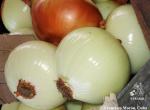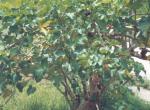sapito (mouth candidiasis)
Allium cepa(In territories with significant traditional TRAMIL use)
Significant uses found by the TRAMIL surveys bulb, macerated in water, applied locally 2 |
Recommandations
Preparation and posology References |
According to published and other information: Use for pneumonia is classified as REC, based on the significant traditional use documented in the TRAMIL surveys, and on available published scientific information. Should there be a notable worsening of the patient’s condition, or should the respiratorydisorder last more than 5 days or 3 days in case of fever, seek medical attention. Due to the health risks involved with pneumonia, an initial medical evaluation is recommended. The use of this resource can be considered complementary to medical treatment, unless it is contraindicated. Use for sapito (thrush) is classified as REC, based on the significant traditional use documented in the TRAMIL surveys, and on available published scientific information. For topical application, strict hygiene measures should be observed in order to avoid contamination or additional infection. |
The bulb of Allium cepa var. aggregatumis widely used for human consumption. For pneumopathy: Grind, mash and squeeze one to two bulbs in a cloth. Mix 15 to 30 mL (1-2 spoons) of juice with honey. Drink before breakfast once a day for 3 weeks. For sapito (mouth candidiasis = thrush): Apply drops of the fresh bulb juice directly on affected area. |
1 GERMOSEN-ROBINEAU L, GERONIMO M, AMPARO C, 1984 2 WENIGER B, ROUZIER M, 1986 3 BLOCK E, NAGANATHAN S, PUTMAN D, ZHAO SH, 1992 4 WU JB, CHENG YD, HUANG SC, CHANG KH, HSIEH MT, 1992 5 TOKITOMO Y, KOBAYASHI A, 1992 6 DONNER H, GAO L, MAZZA G, 1997 7 FULEKI T, 1969 8 PATIL BS, PIKE LM, YOO KS, 1995 9 VAN DEN BERGHE DA, IEVEN M, MERTENS F, VLIETINCK AJ, LAMMENS E, 1978 10 ABOU M, SHIER W, 1990 11 SRINIVASAN D, NATHAN S, SURESH T, PERUMALSAMY PL, 2001 12 SHARMA KC, SHANMUGASUNDRAM SSK, 1979 13 DORSCH W, ETTL M, HEIN G, SCHEFTNER P, WEBER J, BAYER T, WAGNER H, 1987 14 DORSCH W, ADAM O, WEBER J, ZIEGELTRUM T,1985 15DORSCH W, RING J, 1984 16 DORSCH W, WAGNER H, 1991 |
||
Jatropha curcas(In territories with significant traditional TRAMIL use)
Significant uses found by the TRAMIL surveys sap (latex), applied locally1-2 |
Recommandations
Preparation and posology References |
According to published and other information: Use for mouth candidiasis is classified as REC, based on the significant traditional use documented in the TRAMIL surveys and toxicity studies. Not for use during pregnancy, during lactation or by children under 5 years old. Repeated contact with the latex of many Euphorbiaceae results in allergy and in some cases with co-carcinogenicity. Do not ingest the seed due to toxicity risk. In the event of poisoning from ingestion, seek medical attention. |
For mouth candidiasis: There is no available information establishing a means of preparation and dosage other than that referred to by traditional use. Do not use repeatedly. Repeated contact with the latex of many Euphorbiaceae results in allergy and in some cases with co-carcinogenicity. |
1 WENIGER B, ROUZIER M, 1986 Enquête TRAMIL. Service Oecuménique d'Entraide SOE, Port au Prince, Haïti. 2 WENIGER B, 1987-88 Encuesta TRAMIL. enda-caribe, Santo Domingo, Rep. Dominicana. 3 WENIGER B, SAVARY H, DAGUIHL R, 1984 Tri phytochimique de plantes de la liste TRAMIL. Laboratoire de chimie des substances naturelles, Faculté de Médecine et de Pharmacie, Université d'Etat d'Haïti, Port au Prince, Haïti. TRAMIL I, Port au Prince, Haïti, Fac. de Médecine/enda-caribe. 4 VAN DEN BERG A, HOARSTEN S, KETTENES-VAN-DEN BOSCH J, KROES B, BEUKELMAN C, LEEFLANG B, LABADIE R, 1995 Curcacycline A - a novel cyclic octapeptide isolated from the latex of Jatropha curcas L. Febs Lett 358(3):215-218. 5 NATH LK, DUTTA SK, 1991 Extraction and purification of curcain, a protease from the latex of Jatropha curcas Linn. J Pharm Pharmacol 43(2):111-114. 6 HEGNAUER R, 1973 Chemotaxonomy der Pflanzen. Basel & Stuttgart: Birkhauser Verlag. 6:882. 7 SUBRAMANIAN SS, NAGARAJAN S, SULOCHANA N, 1971 Flavonoids from some Euphorbiaceous plants. Phytochemistry 10:2548-2549. 8 HUFFORD C, OGUNTIMEIN B, 1978 Non-polar constituents of Jatropha curcas. Lloydia 41:161. 9 HUSSAIN H, DEENI Y, 1991 Plants in Kano ethomedicine; screening for antimicrobial activity and alkaloids. Int J Pharmacog 29(1):51-56. 10 STIRPE F, PESSION-BRIZZI A, LORENZONI E, STROCCHI P, MONTANARO L, SPERTI S, 1976 Studies on the proteins from seeds of Croton tiglium and of Jatropha curcas. Toxic properties and inhibition of protein synthesis in vitro. Biochem J 156:1. 11 HIROTA M, SUTTAJIT M, SUGURI H, ENDO Y, SHUDO K, WONGCHAI V, HECKER E, FUJIKI H, 1988 A new tumor promoter from the seed oil of Jatropha curcas L., an intramolecular diester of 12-deoxy-16-hydroxyphorbol. Cancer Res 48(20):5800-5804. 12 ROJANAPO W, PIMBUA J, GLINSUKON T, NAENGCHOMNONG W, THEBTARANONTH Y, 1987 Failure of diterpenes from Jatropha curcas to induce mutation in Salmonella typhimurium TA98 and TA100. Res Commun Chem Pathol Pharmacol 58(3):397-400. 13 NAENGCHOMNONG W, THEBTARANONTH Y, WIRIYACHITRA P, OKAMOTO KT, CLARDY J, 1986 Isolation and structure determination of four novel diterpenes from Jatropha curcus. Tetrahedron Lett27(22):2439-2442. 14 DUKE JA, ATCHLEY AA, 1986 Handbook of proximate analysis tables of higher plants. Boca Raton, USA: CRC Press, p90. 15 LE GRAND A, WONDERGEM PA, 1986 Activités antimicrobiennes et études bibliographiques de la toxicologie de dix plantes médicinales de la Caraïbe. Rapport TRAMIL. Dép. de Pharmacognosie, Universités de Groningen & Leyden, Hollande. TRAMIL II, Santo Domingo, Rep. Dominicana, UASD/enda-caribe. 16 SOLIS PN, RODRIGUEZ N, ESPINOSA A, GUPTA MP, 2004 Estudio antimicrobiano de algunas plantas TRAMIL con usos en Martinica. Informe TRAMIL. Centro de Investigaciones Farmacognósticas de la Flora Panameña CIFLORPAN, Facultad de Farmacia, Universidad de Panamá, Panamá, Panamá. 17 THOMASO O, 1989 Re-examination of the antimicrobial activities of Xylopia aethiopica, Carica papaya, Ocimun gratissimum andJatropha curcas. Fitoterapia 60(2):147-155. 18 MACRAE W, HUDSON J, TOWERS G, 1988 Studies on the pharmacological activity of Amazonian Euphorbiaceae. J Ethnopharmacol 22(2):143-172. 19 MARROQUIN E, Blanco JA, 1997 Clinical Trial of Jatropha curcas sap in the treatment of common warts. Fitoterapia 68(2):160-162. 20 HERRERA J, 1990 Determinación de actividades biológicas de vegetales utilizados en medicina tradicional. Informe TRAMIL. Laboratorio de fitofarmacología, Dep. de Farmacología, Facultad de Salud, Universidad del Valle, Cali, Colombia. TRAMIL V, Livingston, Guatemala, CONAPLAMED/enda-caribe. 21 ABDU-AGUYE I, SAMNUSI ALAFIYA T, BHUSNURMATH S, 1986 Acute toxicity studies with Jatropha curcas L. Human Toxicol 5(4):269-274. 22 CHONKEL A, 1985 A propos de quelques graines toxiques existant à la Guadeloupe (Thèse Pharmacie). Faculté de Pharmacie, Montpellier, France. 23 WEE Y, GOPALAKRISHNAKONE P, CHAN A, 1988 Poisonous plants in Singapore - a colour chart for identification with symptoms and signs of poisoning. Toxicon 26(1):47. 24 MAMEESH MS, EL-HAKIM LM, HASSAN A, 1963 Reproductive failure in female rats fed with the fruit or seed of Jatropha curcas. Planta Med 11:98. 25 Olmedo D, RODRIGUEZ N, ESPINOSA A, VASQUEZ Y, Gupta MP, 2005 Ensayo antimicrobiano de algunas especies con usos significativos TRAMIL-Centroamérica. Informe TRAMIL. Centro de Investigaciones Farmacognósticas de la Flora Panameña CIFLORPAN, Facultad de Farmacia, Universidad de Panamá, Panamá, Panamá. 26 LOPEZ M, MOREJON Z, BACALLAO Y, FUENTES V, MORON F, 2009 Irritabilidad dérmica primaria de hoja fresca de Jatropha curcas L.Informe TRAMIL. Facultad de Ciencias Médicas “Dr. Salvador Allende”, Laboratorio Central de Farmacología, C. Habana, Cuba. |
||
Lycopersicon esculentum(In territories with significant traditional TRAMIL use)
Significant uses found by the TRAMIL surveys green fruit and leaf, rubbed in mouth1-2 |
Recommandations
Preparation and posology References |
According to published and other information: Use for candidiasis (thrush) in mouth, toothache and burns is classified as REC, based on the significant traditional use (OMS/WHO)4 documented in the TRAMIL surveys. Traditional use should be limited only to superficial burns (skin injuries) that are not extensive (covering less than 10% of body surface) and are located away from high-risk areas such as face, hands, feet and genitals. For topical application, strict hygiene measures should be observed in order to avoid contamination or additional infection. The leaf should be properly washed and cleaned, and its external indumentum (the covering of hairs on the leaf) should be removed, as it may cause dermatomucosal irritation and reactions of hypersensitivity. |
The ripe fruit of Lycopersicon esculentum is widely used for human consumption. For candidiasis in the mouth and toothache: There is no available information establishing a means of preparation and dosage other than that referred to by traditional use. For burns: Wash injury with cooled boiled water and soap, apply 8-10 grams of leaf, previously washed, on the affected area. Cover the injury with dressing or clean cloth and replace every 12 hours. |
1 WENIGER B, ROUZIER M, 1986 Enquête TRAMIL. Service Oecuménique d'Entraide SOE, Port au Prince, Haïti. 2 WENIGER B, 1987-88 Encuesta TRAMIL. enda-caribe, Santo Domingo, Rep. Dominicana. 3 GIRON L, 1988 Encuesta TRAMIL (Costa atlántica). Centro Mesoamericano de Tecnología CEMAT, Guatemala, Guatemala. 4 WHO, 1991 Pautas para la evaluación de medicamentos herbarios WHO/TRM/91.4 (original inglés). Programa de Medicina Tradicional, OMS, Ginebra, Suiza. 5 HOSTETTMANN K, LEA PJ, (Eds.), 1996 Biologically active natural products. Annual proceedings of the phytochemical society of Europe. Oxford, England: Oxford University Press. 6 SCHREIBER K, AURICH O, 1966 Isolation of several alkaloids and 3-beta-hydroxy-5-alpha-pregn-16-en-20-one from Lycopersicon pimpinellifolium Mill. Phytochemistry 5:707-712. 7 YAHARA S, UDA N, NOHARA T, 1996 Lycoperosides A-C, three stereoisomeric 23-acetoxyspirosolan-3-beta-ol beta-lycotetraosides from Lycopersicon esculentum. Phytochemistry 42(1):169-172. 8 RESCHKE A, HERRMANN K, 1982 Occurrence of 1-o-hydroxycinnamyl-beta-d-glucoses in vegetables I. Phenolic acid compounds of vegetables. Z Lebensm-Unters Forsch 174(1):5-8. 9 VERHOEFF K, LIEM JI, 1975 Toxicity of tomatine to Botrytis cinerea in relation to latency. Phytopathol Z 82:333-338. 10 WILLAMAN J, SCHUBERT B, 1961 Alkaloid-bearing plants and their contained alkaloids. Washington, USA: Tech. Bull. 1234, U.S. Dep. of Agric. 11 HEGNAUER R, 1973 Chemotaxonomy der Pflanzen. Basel & Stuttgart: Birkhauser Verlag. 12 FLEURIET A, MACHEIT J, 1981 Quinyl esters and glucose derivatives of hydroxycinnamic acids during growth and ripening of tomato fruit. Phytochemistry 20(4):667-671. 13 CAVALIN G, 1983 Tomate et tomatine (Thèse Doctorat Pharmacie). Toulouse, France. 14 DUKE JA, ATCHLEY AA, 1986 Handbook of proximate analysis tables of higher plants. Boca Raton, USA: CRC Press. p102. 15 GASPERI-CAMPANI A, BARBIERI L, BATTELLI M, STIRPE F, 1985 On the distribution of ribosome-inactivating proteins amongst plants. J Nat Prod 48(3):446-454. 16 CACERES A, GIRON L, ALVARADO S, TORRES M, 1987 Screening of antimicrobial activity of plants popularly used in Guatemala for the treatment of dermatomucosal diseases. J Ethnopharmacol 20(3):223-237. 17 SHINOHARA K, KUROKI S, MIWA M, KONG ZL, HOSODA H, 1988 Antimutagenicity of dialyzates of vegetables and fruits. Agr Biol Chem 52(6):1369-1375. 18 KONOWALCHUK J, SPEIRS J, 1978 Antiviral effect of commercial juices and beverages. Appl Environ Microbiol 35:1219-1220. 19 SINGH J, DUBEY A, TRIPATHI N, 1994 Antifungal activity of Mentha spicata. Int J Pharmacog 32(4):314-319. 20 SINGH K, PATHAK R, 1984 Effect of leaves extracts of some higher plants on spore germination of Ustilago maydes and U. nuda. Fitoterapia 55(5):318-320. 21 KUBAS J, 1972 Investigations on known or potential antitumoral plants by means of microbiological tests. Part III. Biological activity of some cultivated plant species in Neurospora crassa test. Acta Biol Cracov Ser Bot 15:87-100. 22 CELAYETA F, 1960 Action of the tissues of various plants on the growth of Sphacelia segetum. Farmacognosia (Madrid) 20:91-101. 23 ANON, 1987 Pharmaceutical and cosmetic compositions containing tomato plant extracts for the treatment of skin diseases. Patent-Israëli 78,820. 24 DUFFEY S, ISMAN M, 1981 Inhibition of insect larval growth by phenolics in glandular trichomes of tomato leaves. Experientia 37(6):574-576. 25 HERRERA J, 1990 Determinación de actividades biológicas de vegetales utilizados en medicina tradicional. Informe TRAMIL. Dep. de Farmacología, Facultad de Salud, Universidad del Valle, Cali, Colombia. 26 ASWAL B, BHAKUNI D, GOEL A, KAR K, MAHROTRA B, MUKHERJEE K, 1984 Screening of Indian plants for biological activity: Part X. Indian J Exp Biol 22(6):312-332. 27 DUKE JA, 1988 Handbook of medicinal herbs. Boca Raton, USA: CRC Press. 28 CONTRERAS A, ZOLLA C, 1982 Plantas tóxicas de México. México, México: Instituto Mexicano del Seguro Social. |

